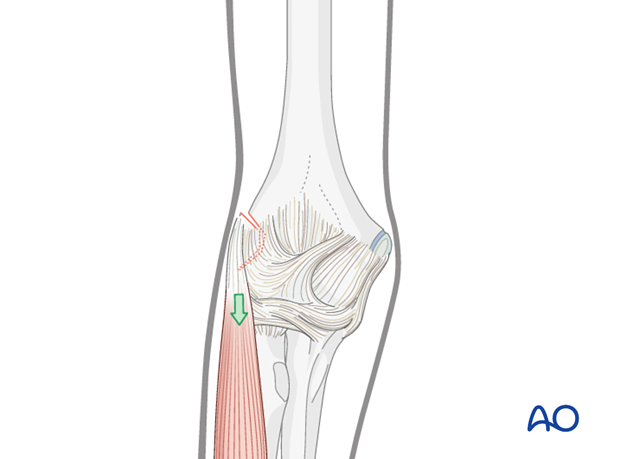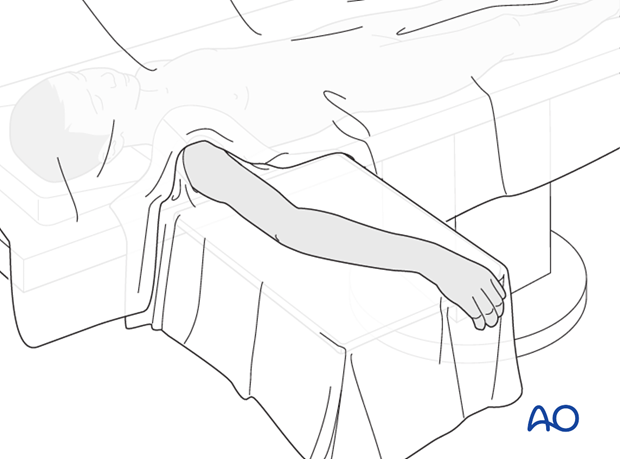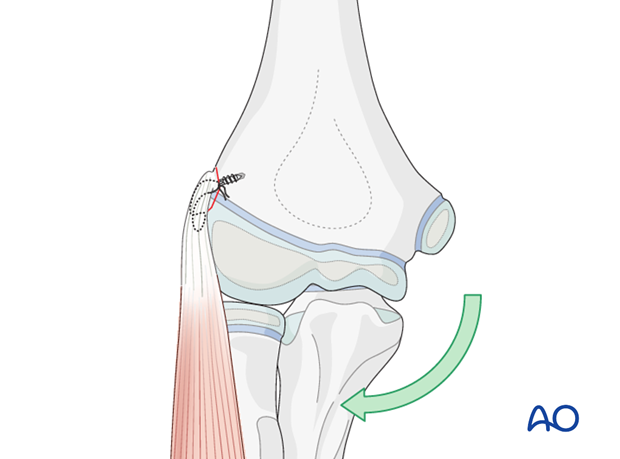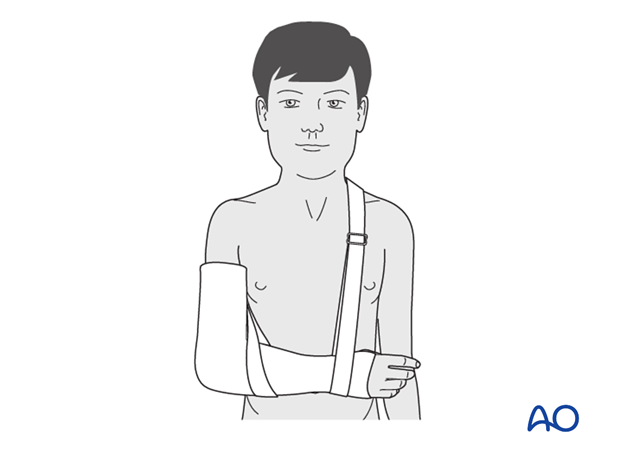Open reduction; suture or suture and anchor fixation
1. Goals and principles
Goals
The main goals of treatment (nonoperative or operative) of these ligament avulsions are:
- Restoration of elbow stability
- Prevention of nonunion of the epicondyle
- Prevention of secondary displacement
Principles
The main principles of treatment for displaced injuries are:
- To achieve reduction and stable fixation
- Restoration and maintenance of elbow stability
Note: The lateral humeral epicondyle is intracapsular.

2. Preparation
Instruments and implants for suture fixation
Sutures are generally used in cases of pure ligamentous avulsion without a bony fragment. This technique can also be used to fix a small bony fragment.
0 or 1 resorbable monofilament suture is generally recommended.

Instruments and implants for anchor fixation
It is recommended that one or two anchors are used. While one anchor may be sufficient, it is recommended that two are used where possible.
The potential disadvantage of anchor fixation is the prominence of the anchor-suture combination. The suture is not resorbable and if prominent and/or painful may require subsequent removal.

Anesthesia and positioning
General anesthesia is recommended and a sterile tourniquet should be available.
The patient is placed supine with the arm draped up to the shoulder.

3. Approach
A standard lateral approach to the elbow is used.
As the lateral epicondyle is visualized the following can be seen:
- In younger children with an isolated cartilage avulsion, the amount of bleeding is minimal
- In older children with a bony avulsion, bleeding is visible from the site of avulsion
Note: In these illustrations, the extensor muscle group is represented by only one muscle.

4. Option 1: Suture fixation
A figure-of-eight suture is inserted into the ligament and avulsed cartilage.

Two drill holes are made at the epicondyle defect (as shown in the illustration).

The needle of the suture is passed through these holes.

Pearl: The forearm is supinated and a valgus stress is applied to the elbow to reduce tension in the extensor muscle mass prior to ligament reduction and reattachment (demonstrated here by the green arrow).

5. Option 2: Anchor fixation
One (or two) drill holes are made in the condylar defect to accommodate the size of the anchors (this step is not necessary if self-drilling, self-tapping anchors are used).

The anchor is inserted and fixed.
The ligament and avulsed cartilage/bone are transfixed with the suture in a figure-of-eight pattern.

Pearl: The forearm is supinated and a valgus stress is applied to the elbow to reduce tension in the extensor muscle mass prior to ligament reduction and reattachment (demonstrated here by the green arrow).

6. Aftercare
Note: Irrespective of the method of fixation, a cast with the forearm in either neutral or supinated position is required to prevent secondary displacement.

Note: In any case of elbow immobilization by plaster cast, careful observation of the neurovascular situation is essential both in the hospital and at home.
See also the additional material on postoperative infection.
It is important to provide parents/carers with the following additional information:
- The warning signs of compartment syndrome, circulatory problems and neurological deterioration
- Hospital telephone number
- Information brochure
If the child remains for some hours/days in bed, the elbow should be elevated on pillows to reduce swelling and pain.

The postoperative protocol is as follows:
- Discharge from hospital according to local practice (1-3 days)
- First clinical and radiological follow-up, depending on the age of the child, 2-3 weeks postoperatively out of the cast
- During the first clinical follow-up parents/carers should be informed about the timing of implant removal
- Physiotherapy is normally not indicated













